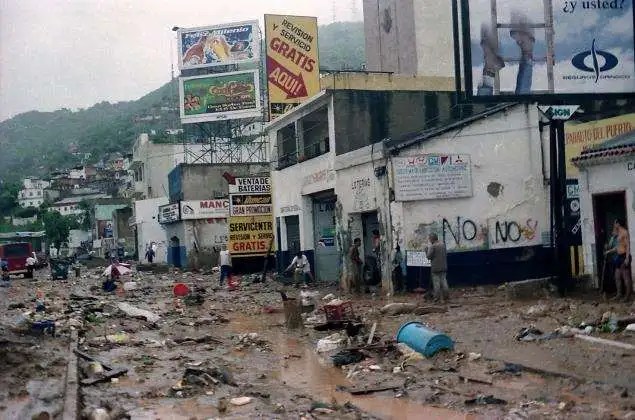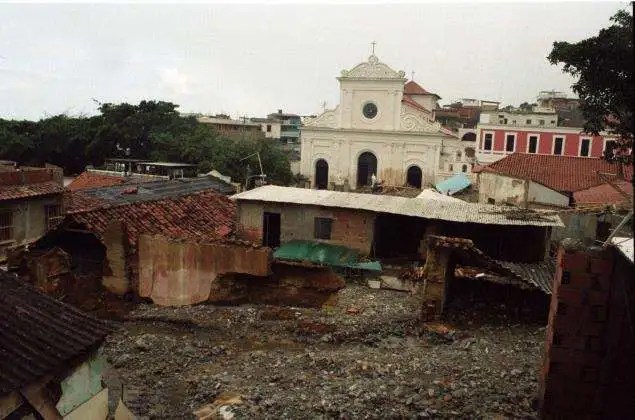
“If nature opposes us, we will fight against it and make it obey us,” is a famous phrase by Simón Bolívar, which the late Hugo Chávez repeated more than two decades ago and which still resonates in the hearts of the people of La Guaira in north central Venezuela who were deeply affected by unending rains and massive landslides in Vargas in 1999.
By Ana C. Guaita Barreto / Correspondent lapatilla.com
It has been 24 years since one of the worst natural disasters in Venezuela occurred: the Vargas tragedy.
This series of mayor landslides left a deep mark on the lives of many people, including Wladimir Sierralta, lieutenant of the Volunteer Division of the Caracas Fire Department and staff of the Medical Service of the Santa María University.
Sierralta, who is also a professor at the National Experimental University of Security and the Santa María University, spoke with our correspondent team in Vargas to tell about his experiences in the midst of the flash floods and landslides that left thousands of families mourning.
This professional collaborated for several days in the rescue of people affected by this natural disaster.

Dark days
Sierralta vividly remembers the days of the tragedy, when torrential rains hit Caracas and Vargas State, leaving a trail of destruction in their wake. The people who lost their homes took refuge in different places, such as ‘La Bandera’ bus terminal, the ‘Nuevo Circo’ bus terminal and the ‘La Carlota’ airport, places set up as field hospitals at the time of this fatal event.
Sierralta, then an emergency medical technician and Civil Defense official, describes the work as arduous and sad, since the magnitude of the disaster was shocking. He remembers having spent almost 15 days in the same clothes, working tirelessly in the rain that never stopped.
During the tragedy, field hospitals and shelters were set up in places such as the ‘Poliedro de Caracas’, ‘Lomas de Urdaneta’, ‘Las Adjuntas’ and ‘Valle-Coche’, under the leadership of Commander Frank González. However, Sierralta mentions that Defensa Civil Caracas did not act directly in Vargas, arguing that Vargas was not its jurisdiction because Vargas was considered another state.
To communicate during the tragedy, the Caracas Firefighters provided Sierralta and his team with a satellite phone, since at that time the digital age did not exist. After 24 years, Sierralta highlights the importance of having an automated system in hospitals and emergency centers, where the victims’ data can be collected to facilitate the location of relatives and their whereabouts, thus avoiding the need to desperately search in the midst of chaos.

Sierralta commented that engineer Frank González, in charge of the technical division of Caracas Civil Defense, was the one who warned about the precipitation amount that kept falling and the worrying overload of the soil. Despite efforts to prevent the disaster, sections of the Caracas – La Guaira highway began to collapse. The tragedy was far from over.
Difficult access
Our interviewee reported that both he and his team were quartered due to the proximity of the date of the Constituent referendum that was taking place at that time, without the Vargas emergency having yet been declared. It was then that former President Hugo Chávez established the ‘civil-military union’, known as ‘Plan Bolívar 2000’, and declared that they would “fight against nature to make it obey.” Paradoxically, the Vargas tragedy occurred immediately after.
On December 15th, Sierralta received the alert of the Vargas disaster. The commander of the Caracas Firefighters, General Rodolfo Briceño, was patrolling the ‘San José de Cotiza’ area with the Metropolitan Police when they were trapped by water. The hospitals, including the Rísquez Hospital, were flooded and the first part of the tragedy began.
According to Sierralta’s story, the Caracas Firefighters and Caracas Civil Defense sent vehicles to assist in the emergency. Sierralta recalled how they were deployed in the ‘El Polvorín’ area, where the water level continued to rise. In the midst of desperation, a group of people who practiced motocross offered their help to reach inaccessible areas and transport people to the field hospital.

Access to Vargas from the capital was extremely difficult, as all the roads were blocked by mountains of dirt and vehicles could only reach the toll station on the Caracas – La Guaira highway near Maiquetía. Sierralta mentioned that from that spot on you could only walk to Los Silos, within the port of La Guaira, since the containers had been swept away by the sea.
Transfers of people and bodies
Given this situation, helicopters, such as “El Ángel Salvador” of the Metropolitan Police, were used to carry out air transfers in collaboration with the Army, the National Guard and other international helicopters. Sierralta remembers that, together with his team, they treated many people with anxiety attacks, injuries and foot and leg injuries from walking through dirt, stones and debris. They were also responsible for identifying and transporting the deceased, a task that lasted several days.
One of the most dramatic aspects of the tragedy was the separation of many families and the loss of children. Sierralta remembers how the children were put on helicopters and taken to the Maiquetía airport, from where they were transferred to different parts of the country. Unfortunately, there was no adequate record of the people who were transferred, which has led many families to continue searching for their loved ones, even after 24 years.
During the tragedy, the field hospitals received donations from people, nurses, doctors, firefighters and Civil Defense officials, as well as the help of numerous volunteers. Sierralta shared the mourning for the more than 30,000 people who lost their lives and the separated families. He highlighted the need for an automated system within the hospital system to facilitate medical registration and help professionals perform their jobs more effectively.
Sierralta also mentioned the lack of coordination that occurred during the tragedy, since all the aid came from Caracas, which generated difficulties in distribution. He especially remembers the emotional impact of a desperate mother in Macuto, who spent the entire day searching for information about her children and pleading for answers.
Rescue staff without supplies to help
Regarding health and emergency personnel, Sierralta highlights the lack of psychological support. Despite being exposed to very traumatic situations they did not have access to the necessary support to deal with the emotional aftermath.
The Vargas tragedy left a deep mark on the life of Wladimir Sierralta and that of many other people. Despite the difficulties and challenges, Sierralta and his team worked tirelessly to provide help to those who needed it most amid the devastation.
His testimony is a reminder of the importance of preparation, coordination and empathy in emergency situations, as well as the need for automated systems that facilitate response and monitoring in cases of natural disasters.

